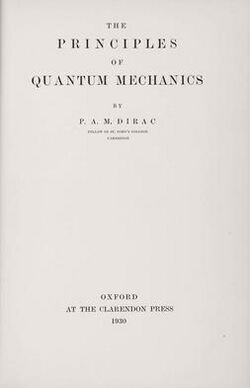Physics:The Principles of Quantum Mechanics
 Title page of the first edition | |
| Author | Paul Dirac |
|---|---|
| Country | United Kingdom |
| Language | English |
| Subject | Quantum mechanics |
| Genres | Non-fiction |
| Publisher | Oxford University Press |
Publication date | 1930 |
| Media type | |
| Pages | 257 |
The Principles of Quantum Mechanics is an influential monograph on quantum mechanics written by Paul Dirac and first published by Oxford University Press in 1930.[1] Dirac gives an account of quantum mechanics by "demonstrating how to construct a completely new theoretical framework from scratch"; "problems were tackled top-down, by working on the great principles, with the details left to look after themselves".[2] It leaves classical physics behind after the first chapter, presenting the subject with a logical structure. Its 82 sections contain 785 equations with no diagrams.[2]
Dirac is credited with developing the subject "particularly in Cambridge and Göttingen between 1925–1927" (Farmelo).[2] It is considered one of the most influential texts on quantum mechanics, with Laurie M. Brown stating that it "set the stage, the tone, and much of the language of the quantum-mechanical revolution".[3]
History
The first and second editions of the book were published in 1930 and 1935.[4]
In 1947 the third edition of the book was published, in which the chapter on quantum electrodynamics was rewritten particularly with the inclusion of electron-positron creation.[4]
In the fourth edition, 1958, the same chapter was revised, adding new sections on interpretation and applications. Later a revised fourth edition appeared in 1967.[4]
Beginning with the third edition (1947), the mathematical descriptions of quantum states and operators were changed to use the Bra–ket notation, introduced in 1939 and largely developed by Dirac himself.[5]
Laurie Brown wrote an article describing the book's evolution through its different editions,[6] and Helge Kragh surveyed reviews by physicists (including Heisenberg, Pauli, and others) from the time of Dirac's book's publication.[7]
Contents
- The principle of superposition
- Dynamical variables and observables
- Representations
- The quantum conditions
- The equations of motion
- Elementary applications
- Perturbation theory
- Collision problems
- Systems containing several similar particles
- Theory of radiation
- Relativistic theory of the electron
- Quantum electrodynamics
See also
Note: This topic belongs to "Physics" portal
- The Evolution of Physics (Einstein and Infeld)
- The Feynman Lectures on Physics Vol. III (Feynman)
- The Physical Principles of the Quantum Theory (Heisenberg)
- Mathematical Foundations of Quantum Mechanics (von Neumann)
References
- ↑ "Paul A.M. Dirac – Biography". The Nobel Prize in Physics 1933. https://www.nobelprize.org/nobel_prizes/physics/laureates/1933/dirac-bio.html. Retrieved September 26, 2011. "Dirac's publications include ... The Principles of Quantum Mechanics (1930; 3rd ed. 1947)."
- ↑ 2.0 2.1 2.2 Farmelo, Graham (June 2, 1995). "Speaking Volumes: The Principles of Quantum Mechanics" (Book review). Times Higher Education Supplement: 20. http://www.timeshighereducation.co.uk/story.asp?sectioncode=26&storycode=162404. Retrieved 2011-09-26.
- ↑ Brown, Laurie M. (2006). "Paul A. M. Dirac's Principles of Quantum Mechanics". Physics in Perspective 8 (4): 381–407. doi:10.1007/s00016-006-0276-4. https://faculty.washington.edu/seattle/physics441/online/about%20Dirac.pdf.
- ↑ 4.0 4.1 4.2 Dalitz, R. H. (1995). The Collected Works of P. A. M. Dirac: Volume 1: 1924–1948. Cambridge University Press. pp. 453–454. ISBN 9780521362313. https://books.google.com/books?id=GBEdMdNWFJIC&pg=453.
- ↑ PAM Dirac (1939). "A new notation for quantum mechanics". Mathematical Proceedings of the Cambridge Philosophical Society 35 (3): 416–418. doi:10.1017/S0305004100021162. Bibcode: 1939PCPS...35..416D.
- ↑ Brown, L.M. (2006), "Paul A.M. Dirac's The Principles of Quantum Mechanics", Physics in Perspective 8 (4): 381–407, doi:10.1007/s00016-006-0276-4, Bibcode: 2006PhP.....8..381B, https://pdfs.semanticscholar.org/fe30/355ffb8cc13644d902e78731569477e92d19.pdf
- ↑ Helge Kragh (2013), Paul Dirac and The Principles of Quantum Mechanics, Research and Pedagogy, Studies 2: A History of Quantum Physics through Its Textbooks, Max-Planck-Gesellschaft zur Förderung der Wissenschaften, ISBN 9783945561249, https://www.mprl-series.mpg.de/studies/2/11/
 |

